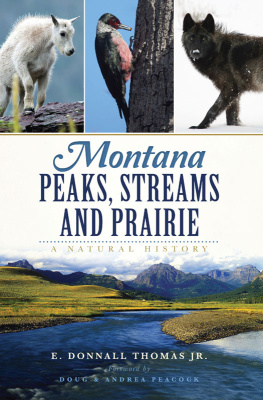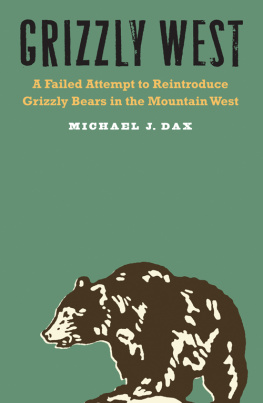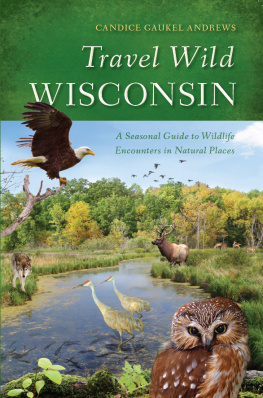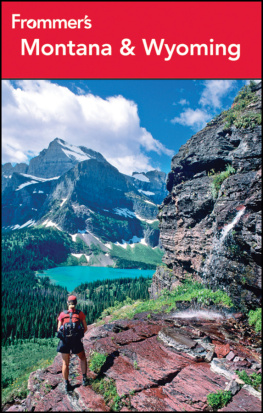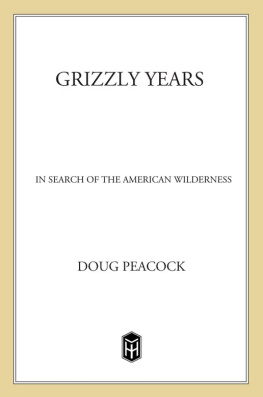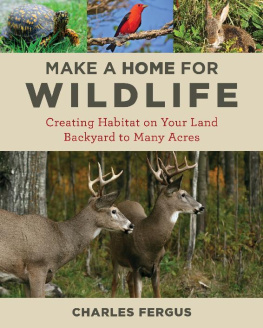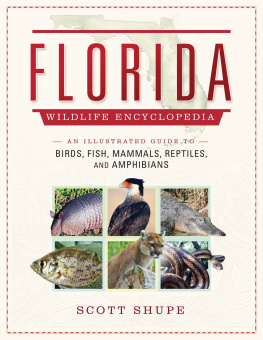

Published by The History Press
Charleston, SC 29403
www.historypress.net
Copyright 2015 by E. Donnall Thomas Jr.
All rights reserved
Front cover, clockwise from top left: Mountain goat in Glacier. Photo by Tim Rains, courtesy of the NPS; Lewiss woodpecker. Photo by Mikes Birds (https://creativecommons.org/licenses/by-sa/2.0/); Lamar Valley wolf with black fur. National Park System photo by Jim Peaco; Soda Creek, Lamar Valley. Public domain.
First published 2015
e-book edition 2015
ISBN 978.1.62585.548.0
Library of Congress Control Number: 2015944407
print edition ISBN 978.1.46711.755.5
Notice: The information in this book is true and complete to the best of our knowledge. It is offered without guarantee on the part of the author or The History Press. The author and The History Press disclaim all liability in connection with the use of this book.
All rights reserved. No part of this book may be reproduced or transmitted in any form whatsoever without prior written permission from the publisher except in the case of brief quotations embodied in critical articles and reviews.
To our parents, Ben and Darlene Beaudry and the late Dorothy and E. Donnall Thomas
CONTENTS
FOREWORD
There has never been a more urgent time for a wide-ranging overview of Montanas natural history. Our climate is in flux with the early signs of global warming manifest in our mountains and watersheds, clearly visible in Glacier National Parks melting ice fields and the near-total loss of whitebark pine forests throughout their range. Continuing droughts are predicted for the state, and with them comes wildfire. Plants and animals of all species face challenging habitat changes, the need for rapid adaptation and, for many, extinction.
To comprehend these changing times, and perhaps help mitigate some of the more dire effects of climate change, we need a modern baseline of understanding. A practical compendium of Montana wildlife is a necessity, told by a worthy guide, literate in the science of wildlife biology and management but also with the authority and personal touch of an elder spinning fables around the campfire.
A trusted guide as author is critical. If we had the choice of a wildlife biologist, game manager, tree-hugging animal lover, mechanized big-game shooter or Native American subsistence hunter, wed go with the aboriginal point of view. But that voice is hard to find and seldom writes books. Our own nominee is E. Donnall Thomas Jr.
Thats because Don Thomass life encompasses all these experiences, and his is probably closest to that old-time hunter. Physician, commercial fisherman, guide, photographer and longbow hunter extraordinaire, Thomas has spent his adult life in the wild outdoors. As a longbow hunter and hunting guide, he has probably spent as much time observingjust watchingwild animals as anyone we know. To succeed as a traditional bow hunter, you need to learn the habitats and behavior of the animals you have selected, scent the wind and begin the long stalk, then silently creep close enough to make the clean killor not, in Thomass case, if conditions dont meet his strict self-imposed standards. This man doesnt care how many fish he has caught.
The organization of this book is simple, efficient and comprehensive: High Country, Timber and Mountainsides, Prairie, Rivers and Streams and, of course, The Top of the Food Chainthe eagles, wolves and bears that roam, or roamed, all over the state and up and down the peaks and valleys. This division of landscapes into provinces and their respective food economies is as an organic way of looking at the land that we know, not unlike the viewpoint of that aboriginal hunter.
Thomass efficiency carries over into language. He nails the essence of grizzly behavior in a single sentence: The high-protein calorie content [in foods like salmon]has allowed brown bears to grow larger than their inland cousins and reduced their need to compete intensely for food. Inland grizzlies, like those in and around Glacier and Yellowstone National Park, have a leaner diet and more aggressive behavior. You could read a number of good books or many dozens of scholarly studies on the subject, but youd come to the same nut of a conclusion.
Similarly, what is the value of a top predator like a wolf? The usual argument is economic, polarized with monotonous animosity, ranchers versus out-of-state environmentalists. Thomas suggests otherwise; the wolfs howl is important because of the sense of wildness it enforces. He speaks of Alaska: No sound that has ever reached my ears has made me appreciate my surrounding more.
We met Thomas a decade ago when he agreed to be interviewed about hunting brown bear with a traditional longbow in the Russian Far East for a book we were writing about grizzly-human relationships. Thomas invited us to his home in Lewistown, Montana, in the lush Judith Basin, overlooking the Big Spring Creek watershed, within sight of some of the most beautiful and under-used mountain ranges in the state: the Snowies, the Belts, the Judith and the Highwoods. Though he might have felt some trepidation about a conversation on bear hunting with Doug, he was generous with his time and his story, inviting us back for another visit to learn more about traditional bowhunting.
The tale Thomas told us of his Russian bear hunt radiated courage. He went after one of the largest predators on the planet armed with a stick and a string. A devotee of fair-chase hunts, he did everything ethically: the tracking, the stalking, the actual killingall were faultless. But something nagged at both of ussomething about the privilege it takes to set up a hunt like this felt like an indulgence and not a good enough reason to kill. In the intervening years, Thomas writes us, hes re-thought his feelings as well: My attitudes have evolved significantly since then, and while Im not recanting anything I said then Im not sure I would respond in quite the same way now. In fact Im sure I wouldnt. I think it would make for an interesting discussion.
This is what makes Thomass work so valuable. He approaches the landscape with an open mind. He sees whats there, not what he expects. He challenges himself physically and intellectually and brings us all along on the journey. Were really looking forward to that discussion.
At a time when the looming catastrophe of climate change threatens to overwhelm and dishearten, perhaps the most effective campaigns are those to save our remaining wild lands. In doing so, we give other species a fighting chance and ourselves some remnants of our original homeland. Its a service to the planet, and armed with the kind of knowledge in this book, its a fight we can win.
Doug and Andrea Peacock are Montana authors whose latest book is
In the Shadow of the Sabertooth: Global Warming, the Origins of the First Americans,
and the Terrible Beasts of the Pleistocene
ACKNOWLEDGEMENTS
Many people contributed factual information and constructive criticism while I was preparing this text. At the risk of a regrettable omission, I would like to thank the following: Ed Arnette, Ed Bangs, Mike and Karen Hoffman, Mona Longknife, Tom McGuane, Doug and Andrea Peacock, John Roseland, Diana Six, David Tetzlaff and Ken Smoker.
My old friend Dick LeBlond, whose background in both biological science and the outdoors mirrors my own, boldly volunteered to review this entire manuscript for accuracy, for which I cannot thank him enough.
Next page
